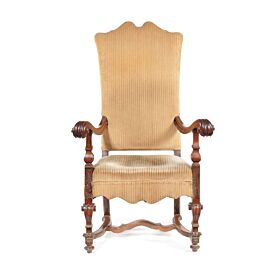Provenance:
The Gallery, Balls Park, Hertford.
Constructed between 1637-1640 by the financier Sir John Harrison to the designs of Nicholas Stone, Balls Park was remodelled by Harrison's son, Richard and grandson Edward, who had served in the colonial government of the East India Company. In the late 18th century Balls Park passed to the Marquesses Townshend of Raynham, Norfolk. It was extended by Sir Robert Lorimer for the Faudel-Phillips family in the 1920's who had purchased the house from the Townshend's in 1901.The estate was sold in 1946 and became an education centre until it closed in 2002, it is now private apartments.
Carved in low relief and constructed in different coloured woods built up into layers, these intarsia panels are indicative of work carried out in family workshops from the German city of Eger during the mid-17th century. High quality examples such as these are often attributed to the Eck family. Peter Eck (b.1538) was a sculptor as well as a journeyman and originated from Nurnberg. It was his grandson Adam (1604-1664) who became the most renowned and is generally recognised as being the first person to introduce this type of three-dimensional marquetry inlay. His patrons included Leopold William of Habsburg and members of the Bohemian, German and Swedish aristocracy. The jousting knight is represented on several other cabinets attributed to Eck; one in the collection of the Duke of Hohenlohe in the Museum Schloss Neuenstein and another on a cabinet in the Royal Ontario Museum of Toronto.
See Sotheby's, Amsterdam, 21 December 2005, lot 295 for a German Eger marquetry cabinet, 17th century and later, and Christies 13 June, 2002, lot 25 for a table cabinet attributed to Adam Eck.
A raresilver-mounted relief-carved fruitwood marquetry and walnut folding games box by Adam Eck, signed and dated 1664 was offered Christies, The Exceptional Sale, 7 July 2016. See also H.Kreisel, Die Kunst Des Deutschen Möbels, Vol I, fig. 382 for an Eger cabinet attributed to Eck in the Frankfurt Museum für Kunsthandwerk.





